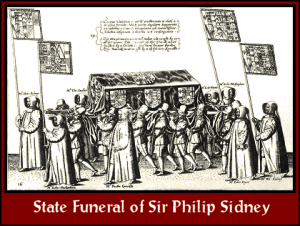Funerals and Mourning
Parish registers show that about 8% to 16% of the population was over 60 at time of death.
The infant and early childhood death rate contributes more to low average life expectancy than death at old age. Barring plague, war, accident, crime, and childbed, if you live to be 12, you can live to be 70.
People do not get old earlier, even though the average life expectancy is lower than today. Men only start describing themselves as "old" at about 50.
Death is, however, inevitable, and like marriage, it is a community affair.

Tokens of mourning
Black is the color for mourning. Depending on the wealth and status of the family, black cloth for gowns may be provided to invited mourners. For the funeral procession, some people even go so far as to blacken the soles of the shoes.
The family may provide black pins, ribbons, stockings, even black ruff, hoods, and gloves.
Black armbands do not appear to be an Elizabethan custom. Instead, sprigs of rosemary may be worn in a hatband or pinned to a sleeve as a way of identifying those in mourning.
Mourning gear helps to distinguish the actual mourners from mere on-lookers.
Wills often specify certain people to have mourning rings made for them. These are always purpose-made, usually memento mori: a remembrance of death, in the form of skulls, coffins, skeletons and crosses.
The most elaborate funeral processions feature servants carrying banners and escutcheons (coats of arms). Church bells are rung while the mourners walk with the coffin to the churchyard.
Attendants are dressed in black gowns and carrying black staves.
The range kinship for mourning purposes extends beyond the immediate family to include servants and other dependants, whether or not they are related by blood.
The body is washed, usually by the midwife or other sober women, and wrapped in a winding sheet before being placed in the coffin.
The corpses of maidens are always decked with flowers.
Suicides cannot be buried in the churchyard or any hallowed ground. It is believed that sailors buried at sea are more likely to become ghosts, as their burial ground is unhallowed.
Graveside
Both the grave and the coffin itself are draped in black. Aubrey reports the custom of putting a penny in the corpse's mouth to give to St Peter at the pearly gates. Christians don't believe in a ferryman.
A cross of folded linen strips would be draped over the coffin. In fact, crosses may be used all over the place in remembrance of Christ's death and resurrection.
Candles are also commonly used to light the soul's way.
There is no evidence of cut flower arrangements or sprays. The only flowers mentioned are those cast into a child's or maiden's grave. For men and married women, herbs such as rue and rosemary are more common.
Feasting
Money is often distributed to the poor and a feast held afterward, to which the whole village or neighborhood is invited.
For more modest families, the feasting may be limited to cakes baked in funereal shapes and ale, claret, and brandy.
Memorials
For ordinary parishioners, there are no headstones or markers in the church graveyard. If you can afford to be buried inside the church, they ordinarily lift a flagstone or two from the floor and dig the grave there, then re-lay the stone. The stone may be cut with suitable biography and mottoes in Latin or English, or it may be left blank.
When the churchyard becomes so crowded that digging a new grave means turning up old ones, the bones are collected and stored in a charnel house—usually a building behind the church.
The wealthy may prefer to be interred in a monument in a private chapel or memorial vault, usually in or near their own manor church.
Widowhood

Between 25% and 30% of widows remarry, generally in the first year of their widowhood. For widowers, especially those with young children, the percentage is even higher.
The widow's third and any other inheritance is her property for life, and returns to the estate at her death, unless she marries. Then she can take it with her into the new marriage.
Widows with property of their own are more in demand for remarriage during times when land is scarce or expensive to come by.
A young man generally prefers a young wife when land is cheap or when he has established himself successfully. Otherwise, a wealthy widow is a desirable commodity.
Not all widows are old, especially those who married much older men as a second or third wife.
Sources:
Cressey, Birth, Marriage, and Death
Duffy, The Voices of Morebath
Diary of Henry Machyn
Hanawalt, Ties that Bound
McDermott & Berk, Life and Times of William Shakespeare
![]() Love and Marriage
Love and Marriage
![]() Heirs & Inheritance
Heirs & Inheritance





10 March 2010 mps
